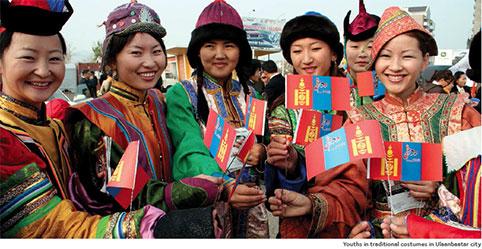"Өнөр бүл" хүүхдийн асрамжийн төв 50 нас хүрлээ
Францын Версалийн хааны ордны дуурийн театрын найрал хөгжимчид Монгол Улсад анх удаа тоглоно
Өнөөдөр цахилгаан хязгаарлах хуваарь
МАН газрын наймаачдыг зарлах сонсголоо цуцлав
Улаанбаатарт өдөртөө 15 градус дулаан байна
“Төв цэнгэлдэх хүрээлэн” ХХК-ийн гүйцэтгэх захирлаар Ж.Энхжаргаланг томиллоо
Зөвшөөрөлгүй хашаа хайс, хаяг, сурталчилгааны самбарыг буулгаж байна
Сагсан бөмбөгийн 3х3 шигшээ баг тамирчдыг “Go Mongolia” элчээр өргөмжлөн батламж гардууллаа
Нутгийн зарим хэсгээр бороо, нойтон цас орно
Нөөцийн махны өргөтгөсөн худалдааг 25 байршилд зохион байгуулна
10 Amazing Facts About The Mongols
10.Mongol Women
Historians tend to portray Mongol men as fearsome and mighty conquerors, but the women are often ignored. This is quite unfair, as in the Mongol civilization it was actually the women who called the shots. While their men were busy being, well, Mongol warriors, the women kept the economy going and held some of the highest positions in their shamanistic religion. This put the Mongol ladies in a position of power that their European contemporaries could only dream about.
The women weren’t just happy with running the businesses and religion, either—the Mongols also had several female rulers. After Genghis Khan’s death, his daughters and daughters-in-law embarked on a series of power struggles that saw various capable women rule their own factions of the Empire, at least for a while (it was a turbulent time).
One of the mightiest Mongol queens was Mandhuhai, a capable warrior with a keen tactical mind. She fought to unite the Mongol kingdoms like Genghis had done, conquering enemy after enemy in a series of victorious battles. When she was in her thirties, it occurred to her she should probably keep her family name going—but she was still busy with her wars. Mandhuhai solved this conundrum by marrying a 17-year-old trophy prince and bearing eight children, all while actively participating in battles.
9.The Postal System
Mongols were wanderers by nature, so efficient communication between their leaders and officers was both vital and extremely difficult. They solved this issue by inventing an incredibly efficient postal system called Yam (or Örtöö, meaning “checkpoint”).
Many foreign visitors, including Marco Polo himself, were in awe of Yam’s size and reliability. It was a vast collection of postal stations, with dedicated messengers delivering mail, intelligence reports, and important news from station to station. These stations were about 24–64 kilometers (15–40 mi) apart, and were kept constantly staffed. At one point, there were at least 1,400 stations in China alone, and the messengers had 50,000 fresh horses at their disposal.
8.Tactics
The Mongols were renowned as effective and terrifying battle tacticians, who honed their skills by fighting a lot. Even famous historical commanders, like Alexander the Great and Hannibal Barca, start to look a lot less impressive when their achievements are compared to lesser Mongol generals.
The Mongols relied heavily on shock tactics. Fake withdrawals, surprise attacks, psychological warfare, and even hostage-taking and human shields were classic Mongol moves. They liked to start a fight by showering the enemy with armor-piercing arrows, followed by a brutal cavalry charge. Often, the enemy would be lured toward hidden archers by a weaker Mongol force that pretended to flee. When attacking large targets (such as cities, which they could easily take two at a time), they liked to advance on extremely wide fronts, using the Yam system to communicate. They were also experts at siege technology and were deliberately brutal to people who didn’t submit to their rule. This tactical combination made them the premier fighting force of their era.
7.The Silk Road
One of the most ruthless, yet efficient, parts of Genghis Khan’s reign was his brutal conquest of the Silk Road, the main trade route between Asia and Europe, and one of the largest (if not the absolute largest) sources of income for the Mongol empire. Realizing that even his massive army could not fully conquer and keep the 6,437-kilometer (4,000 mi) route, he adopted a secondary strategy. Genghis started destroying every single Arabic and Turkish settlement on the road, until every city and oasis on the whole stretch was either in ruins or on their knees before him. This took a lot of time, and he did not live to see his plan take full effect, but once the Mongols finally gained control of the route, they hung onto it: The Silk Road was entirely under Mongol control for the majority of the 14th and 15th centuries. Surprisingly (considering how it was achieved), Mongol rule was not a death knell for the road. They treated traders well and managed to not only encourage, but actually invigorate, caravan trade between the Mediterranean and China. However, passing through the Mongol-era Silk Road was not cheap: Most of the revenue its trade created went straight into the deep pockets of the Mongols, in the form of various tolls and taxes.
6.Pax Mongolica
Sometimes, when people go to war hard enough, the end result is peace. The Pax Mongolica was a period of peace and prosperity that followed the Mongol conquests in the 13th and 14th Centuries. At that point, Mongols were at the height of their powers. Their empire stretched nearly 15 million square kilometers (9.3 million sq mi) and contained over 100 million people. For reference, the United States has 9.83 million square kilometers (3.79 million sq mi) of land.
Because this vast land was under a common government, with an efficient communication system and booming international trade, the empire thrived and everyone was happy. The fearsome Mongols had actually managed to create one of the most peaceful periods in history.
5.The Golden Horde
One of the most powerful Mongol empires was the Golden Horde, a large kingdom established by Genghis Khan’s grandson, Batu Khan, in 1251. Its name paints it as little more than a massive cluster of savages in tents, but it was actually a powerful, highly infrastructured country with surprisingly modern stone cities, in particular the capital, Sarai-Batu.
The Golden Horde had massive influence on other cultures as well. Presiding over an area that covered parts of modern Russia, Ukraine, Kazakhstan, Moldova, and the Caucasus, they were connected with both Muslims and Russians. The Horde gleefully terrorized the Russians, who actually ended up in a secluded Dark Age because of their Mongol neighbors. Muslims were luckier: The traditionally shamanistic Mongol leaders embraced and eventually adopted their religion.
4.Weapons
Nomads at heart, Mongols fought on horseback whenever they could. The horse’s own impressive power was recognized, and the horse was often considered a weapon in and of itself. Naturally, many Mongol weapons are designed for riding. Their swords were curved sabers, easy to handle both on horseback and on foot. Lances, maces, and daggers were also commonly used. Some Mongols used gunpowder as explosive bombs and grenades.
The most common long-distance weapon was the composite bow, a small but sturdy weapon that had twice the range of the English longbow. They used several types of arrows depending on the situation: Some were ideal for piercing, while others were iron-headed and could fly particularly long distances. They even had Hawkeye-like trick arrows. The most famous was the whistle arrow, a hollow arrow that made a loud whistling sound when it was fired. It was handy for scaring the enemy, but even handier for signaling: Mongol hordes were huge, noisy things where shouted commands were hard to hear (especially during a charge), so commanders would fire these arrows as signals for the troops. Fire arrows were also used, as were scare-tactic trap arrows that caused terrifying wounds, leaving the enemy wailing on the battlefield. Armor wasn’t used until the latter stages of the Mongol era. Instead of the chain mail most armies used, Mongols preferred light leather armor that was made by soaking horse skin in urine. They also armored the horses.
3.Tolerance
The Mongols decided very early on that in order to conquer a giant empire, they had to accept the habits of the people they conquered. They were happy to let their subjects keep their religion and important cultural habits and actually actively encouraged this with things like tax reductions for priests. Since Mongols themselves had a very open and relaxed attitude toward religion, this cost them practically nothing—and provided a valuable tool in keeping the conquered nations content.
2.Tatars
Mongols were occasionally referred to as Tatars (or Tartars) by the people they terrorized. This was originally derived from Tata, a name the Mongols call themselves. However, when people realized this sounded a lot like Tartarus, Roman mythology’s variation of Hell, they started calling Mongols Tatars—“people from Tartarus,” meaning demons from hell.
The Tatar name is still in use, though it is not quite as threatening anymore. Today, “Tatar” refers to ethnically Turkish people who mainly live in Russia, Kazakhstan, and Siberia.
1.Subutai
Subutai, also known as Subedei, was one of the gest reasons why Genghis Khan was able to form the Mongol Empire. He was one of Genghis’s “Four Dogs of War” and the Mongol’s chief strategist. Subutai is considered one of the most brilliant military tacticians in history, and easily the most skilled general in an army already full of insanely skilled and fearless leaders.
Subutai pioneered the use of siege weaponry and military intelligence. He always found out what tactics the opponent used before devising his own, which enabled him to come up with the most effective counterattacks. He constantly taught himself new things by consulting with engineers and wise men alike, until he became a whirlwind of military knowledge that was thought to be completely unstoppable.
When Genghis Khan died during the conquest of China and his son Ogedai replaced him, Subutai continued to serve him. Together, Ogedai and Subutai turned their attention toward Europe. They defeated a few armies and were just gearing up to invade Central Europe when Ogedai died in 1241. In a massive stroke of luck for Europe, his successor, Guyuk Khan, removed Subutai from the European front for political reasons and sent him to China. Subutai, 70 years old at the time, obliged, battling in China for a year before returning back home to die of old age.

Mongolia still exists today, but the Mongols who live there now aren’t the ones history books will remember. After all, their ancestors roamed the land on horseback, pillaging and conquering with the kind of mercilessness Vikings could only dream of.
Well, that’s the popular image, anyway. Old-timey Mongols were definitely fearsome warriors, but they were also a surprisingly advanced and cultured people.
Well, that’s the popular image, anyway. Old-timey Mongols were definitely fearsome warriors, but they were also a surprisingly advanced and cultured people.
10.Mongol Women
Historians tend to portray Mongol men as fearsome and mighty conquerors, but the women are often ignored. This is quite unfair, as in the Mongol civilization it was actually the women who called the shots. While their men were busy being, well, Mongol warriors, the women kept the economy going and held some of the highest positions in their shamanistic religion. This put the Mongol ladies in a position of power that their European contemporaries could only dream about.
The women weren’t just happy with running the businesses and religion, either—the Mongols also had several female rulers. After Genghis Khan’s death, his daughters and daughters-in-law embarked on a series of power struggles that saw various capable women rule their own factions of the Empire, at least for a while (it was a turbulent time).
One of the mightiest Mongol queens was Mandhuhai, a capable warrior with a keen tactical mind. She fought to unite the Mongol kingdoms like Genghis had done, conquering enemy after enemy in a series of victorious battles. When she was in her thirties, it occurred to her she should probably keep her family name going—but she was still busy with her wars. Mandhuhai solved this conundrum by marrying a 17-year-old trophy prince and bearing eight children, all while actively participating in battles.
9.The Postal System
Mongols were wanderers by nature, so efficient communication between their leaders and officers was both vital and extremely difficult. They solved this issue by inventing an incredibly efficient postal system called Yam (or Örtöö, meaning “checkpoint”).
Many foreign visitors, including Marco Polo himself, were in awe of Yam’s size and reliability. It was a vast collection of postal stations, with dedicated messengers delivering mail, intelligence reports, and important news from station to station. These stations were about 24–64 kilometers (15–40 mi) apart, and were kept constantly staffed. At one point, there were at least 1,400 stations in China alone, and the messengers had 50,000 fresh horses at their disposal.
8.Tactics
The Mongols were renowned as effective and terrifying battle tacticians, who honed their skills by fighting a lot. Even famous historical commanders, like Alexander the Great and Hannibal Barca, start to look a lot less impressive when their achievements are compared to lesser Mongol generals.
The Mongols relied heavily on shock tactics. Fake withdrawals, surprise attacks, psychological warfare, and even hostage-taking and human shields were classic Mongol moves. They liked to start a fight by showering the enemy with armor-piercing arrows, followed by a brutal cavalry charge. Often, the enemy would be lured toward hidden archers by a weaker Mongol force that pretended to flee. When attacking large targets (such as cities, which they could easily take two at a time), they liked to advance on extremely wide fronts, using the Yam system to communicate. They were also experts at siege technology and were deliberately brutal to people who didn’t submit to their rule. This tactical combination made them the premier fighting force of their era.
7.The Silk Road
One of the most ruthless, yet efficient, parts of Genghis Khan’s reign was his brutal conquest of the Silk Road, the main trade route between Asia and Europe, and one of the largest (if not the absolute largest) sources of income for the Mongol empire. Realizing that even his massive army could not fully conquer and keep the 6,437-kilometer (4,000 mi) route, he adopted a secondary strategy. Genghis started destroying every single Arabic and Turkish settlement on the road, until every city and oasis on the whole stretch was either in ruins or on their knees before him. This took a lot of time, and he did not live to see his plan take full effect, but once the Mongols finally gained control of the route, they hung onto it: The Silk Road was entirely under Mongol control for the majority of the 14th and 15th centuries. Surprisingly (considering how it was achieved), Mongol rule was not a death knell for the road. They treated traders well and managed to not only encourage, but actually invigorate, caravan trade between the Mediterranean and China. However, passing through the Mongol-era Silk Road was not cheap: Most of the revenue its trade created went straight into the deep pockets of the Mongols, in the form of various tolls and taxes.
6.Pax Mongolica
Sometimes, when people go to war hard enough, the end result is peace. The Pax Mongolica was a period of peace and prosperity that followed the Mongol conquests in the 13th and 14th Centuries. At that point, Mongols were at the height of their powers. Their empire stretched nearly 15 million square kilometers (9.3 million sq mi) and contained over 100 million people. For reference, the United States has 9.83 million square kilometers (3.79 million sq mi) of land.
Because this vast land was under a common government, with an efficient communication system and booming international trade, the empire thrived and everyone was happy. The fearsome Mongols had actually managed to create one of the most peaceful periods in history.
5.The Golden Horde
One of the most powerful Mongol empires was the Golden Horde, a large kingdom established by Genghis Khan’s grandson, Batu Khan, in 1251. Its name paints it as little more than a massive cluster of savages in tents, but it was actually a powerful, highly infrastructured country with surprisingly modern stone cities, in particular the capital, Sarai-Batu.
The Golden Horde had massive influence on other cultures as well. Presiding over an area that covered parts of modern Russia, Ukraine, Kazakhstan, Moldova, and the Caucasus, they were connected with both Muslims and Russians. The Horde gleefully terrorized the Russians, who actually ended up in a secluded Dark Age because of their Mongol neighbors. Muslims were luckier: The traditionally shamanistic Mongol leaders embraced and eventually adopted their religion.
4.Weapons
Nomads at heart, Mongols fought on horseback whenever they could. The horse’s own impressive power was recognized, and the horse was often considered a weapon in and of itself. Naturally, many Mongol weapons are designed for riding. Their swords were curved sabers, easy to handle both on horseback and on foot. Lances, maces, and daggers were also commonly used. Some Mongols used gunpowder as explosive bombs and grenades.
The most common long-distance weapon was the composite bow, a small but sturdy weapon that had twice the range of the English longbow. They used several types of arrows depending on the situation: Some were ideal for piercing, while others were iron-headed and could fly particularly long distances. They even had Hawkeye-like trick arrows. The most famous was the whistle arrow, a hollow arrow that made a loud whistling sound when it was fired. It was handy for scaring the enemy, but even handier for signaling: Mongol hordes were huge, noisy things where shouted commands were hard to hear (especially during a charge), so commanders would fire these arrows as signals for the troops. Fire arrows were also used, as were scare-tactic trap arrows that caused terrifying wounds, leaving the enemy wailing on the battlefield. Armor wasn’t used until the latter stages of the Mongol era. Instead of the chain mail most armies used, Mongols preferred light leather armor that was made by soaking horse skin in urine. They also armored the horses.
3.Tolerance
The Mongols decided very early on that in order to conquer a giant empire, they had to accept the habits of the people they conquered. They were happy to let their subjects keep their religion and important cultural habits and actually actively encouraged this with things like tax reductions for priests. Since Mongols themselves had a very open and relaxed attitude toward religion, this cost them practically nothing—and provided a valuable tool in keeping the conquered nations content.
2.Tatars
Mongols were occasionally referred to as Tatars (or Tartars) by the people they terrorized. This was originally derived from Tata, a name the Mongols call themselves. However, when people realized this sounded a lot like Tartarus, Roman mythology’s variation of Hell, they started calling Mongols Tatars—“people from Tartarus,” meaning demons from hell.
The Tatar name is still in use, though it is not quite as threatening anymore. Today, “Tatar” refers to ethnically Turkish people who mainly live in Russia, Kazakhstan, and Siberia.
1.Subutai
Subutai, also known as Subedei, was one of the gest reasons why Genghis Khan was able to form the Mongol Empire. He was one of Genghis’s “Four Dogs of War” and the Mongol’s chief strategist. Subutai is considered one of the most brilliant military tacticians in history, and easily the most skilled general in an army already full of insanely skilled and fearless leaders.
Subutai pioneered the use of siege weaponry and military intelligence. He always found out what tactics the opponent used before devising his own, which enabled him to come up with the most effective counterattacks. He constantly taught himself new things by consulting with engineers and wise men alike, until he became a whirlwind of military knowledge that was thought to be completely unstoppable.
When Genghis Khan died during the conquest of China and his son Ogedai replaced him, Subutai continued to serve him. Together, Ogedai and Subutai turned their attention toward Europe. They defeated a few armies and were just gearing up to invade Central Europe when Ogedai died in 1241. In a massive stroke of luck for Europe, his successor, Guyuk Khan, removed Subutai from the European front for political reasons and sent him to China. Subutai, 70 years old at the time, obliged, battling in China for a year before returning back home to die of old age.
0 Сэтгэгдэл





















